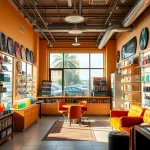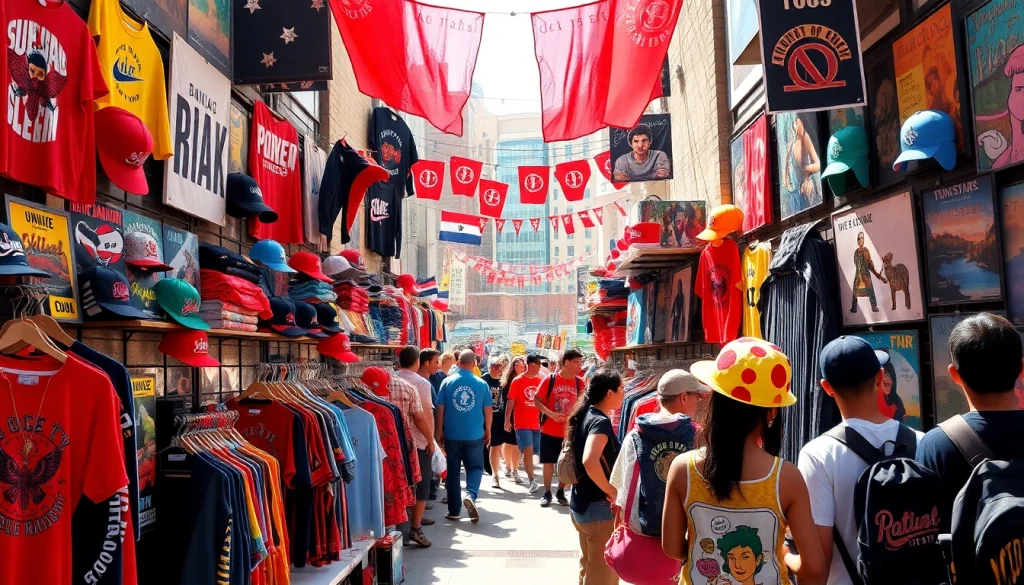Understanding Merchandise Fundamentals
In the dynamic world of music, merchandise has emerged as a vital component for artists looking to expand their brand beyond just music sales. Merchandise, ranging from apparel to collectibles, not only generates additional revenue but also strengthens the connection between the artist and their fans. Building a solid merchandise strategy can enhance an artist’s brand identity and create loyal followers. Whether you’re a budding artist or an established name, understanding merchandise fundamentals is essential for success. One of the key elements is knowing your target audience and what resonates with them.
Successful artists find ways to seamlessly integrate their merchandise with their overall brand image and communication. This follows through to their merchandise offerings which should resonate with their unique style and artistic vision. In the following sections, we will explore the importance of merchandise, the various types one can consider, and how to understand your target audience for an effective merchandise strategy.
The Importance of Merchandise for Artists
Merchandise plays a pivotal role for artists, serving multiple functions. Firstly, it acts as a vital revenue stream. Live concerts and digital streaming have shifted how artists earn their living, making merchandise sales increasingly important. According to a report by Statista, the merchandise industry within the music sector is projected to grow significantly, highlighting its potential as a critical income source.
Secondly, merchandise strengthens fan engagement. Creating products that fans can identify with fosters a sense of belonging and connection to the artist’s world. When fans wear a t-shirt featuring their favorite artist, they’re not merely showcasing their musical preference; they are signaling their identity and loyalty to that artist. With time, this connection can lead to increased loyalty and support, making fans more willing to engage with the artist’s other endeavors.
Types of Merchandise to Consider
When it comes to merchandise, variety and creativity are key. Here are some popular categories:
- Apparel: T-shirts, hoodies, hats, and other wearable items are staples in an artist’s merchandise lineup.
- Accessories: Items such as bracelets, necklaces, and pins allow fans to carry their admiration for the artist in subtler ways.
- Collectibles: Vinyl records, signed posters, and limited-edition items often cater to devoted fans looking for something special.
- Home Goods: Products like mugs, throw pillows, and artwork bring an artist’s brand into the fans’ living spaces.
Identifying which types of merchandise align best with the artist’s brand and audience demands careful consideration. Surveys, social media engagement, and fan feedback can provide insights into what fans want most.
Target Audience Insights
Understanding the target audience is crucial in formulating an effective merchandise strategy. An artist should pinpoint their primary demographic, including age, interests, and psychographics, which will inform product design and marketing tactics. For instance, a younger audience may be more inclined toward trendy and stylish apparel, while older fans may appreciate more vintage or classic designs.
Conducting market research through questionnaires or polls on social media platforms can help gather valuable feedback. Additionally, observing competitors and analyzing their merchandise can reveal trends and gaps in the market. Ultimately, the better an artist knows their audience, the more effectively they can cater to them with tailored merchandise offerings.
Designing Unique Merchandise
Creative Approaches to Product Design
Designing merchandise that stands out demands creativity and innovation. Artists should consider unique themes and visual storytelling that reflects their brand identity. Collaborating with graphic designers or artists can introduce new perspectives in the design process, resulting in compelling visuals that appeal to fans.
One creative approach is to tie merchandise designs to specific song lyrics, album covers, or themes of an artist’s music. This creates a deeper emotional connection with fans who not only appreciate the aesthetic but also resonate with the message behind the artwork. Furthermore, artists can frequently update their merchandise to include seasonal designs, limited-edition items, or exclusive collaborations, making fans eager to purchase and collect.
Branding Elements in Merchandise
Consistent branding is crucial when designing merchandise. Logos, color schemes, and typography should align closely with an artist’s overall brand aesthetics. This coherence helps fans instantly recognize the merchandise as part of an artist’s image, reinforcing brand identity and loyalty.
Additionally, using eco-friendly materials or supporting a charitable cause through merchandise can enhance brand perception. Fans often respect and support brands that promote sustainability and social responsibility. This not only elevates the artist’s image but also aligns the merchandise with a broader movement, increasing its attractiveness to consumers who are becoming more conscious of their purchasing decisions.
Choosing Materials and Quality Standards
Quality is a non-negotiable when it comes to merchandise. Low-quality items may disappoint customers and even tarnish an artist’s reputation. Therefore, sourcing quality materials is critical. For example, 100% cotton garments not only feel good but also last longer, creating a better experience for consumers.
Additionally, conducting product tests (including wear tests and durability assessments) can provide insights into the longevity of merchandise items. An artist should also continually seek feedback from fans regarding quality and make adjustments accordingly. This commitment to quality can differentiate an artist’s merchandise from competitors and instill confidence and satisfaction in fans.
Marketing Your Merchandise Effectively
Social Media Promotion Strategies
In today’s digital landscape, social media is an indispensable tool for marketing merchandise. Artists can use platforms like Instagram, Twitter, and TikTok to showcase their products creatively. Visual platforms are particularly effective in grabbing attention; hence, visually appealing posts showing merchandise in use can create buzz and excitement.
Engaging content such as behind-the-scenes looks during product design, unboxing videos, or limited-time offers can create urgency and encourage purchasing. Posting polls or questions related to merchandise can help foster a sense of community and keep fans engaged with the brand. Influencing purchases through social proof by reposting fan photos wearing their merchandise further amplifies visibility.
Collaborations and Partnerships
Collaborating with other artists, brands, or influencers can open new avenues for merchandise marketing. Joint ventures allow artists to tap into each other’s audiences, expanding their reach. Influencer marketing, in particular, can be beneficial, as it provides authentic endorsements that resonate with potential customers.
Artists should identify collaborators who align with their values and aesthetics to create cohesive merchandise that appeals to both fan bases. Such partnerships often yield unique, limited-time product offerings, generating excitement and making merchandise more desirable.
Utilizing Influencer Marketing
Influencer marketing can supercharge merchandise sales by leveraging the reach of social influencers who have established relationships with specific audiences. Partnering with influencers who share a similar aesthetic or message as the artist can foster authentic promotion. Providing influencers with exclusive merchandise or collaborating on custom designs can create a win-win situation for both parties.
Measuring the impact of influencer campaigns through engagement rates and referral codes can provide valuable insights into campaign effectiveness, shaping future marketing strategies.
Distribution Channels for Merchandise
Online Store Setup and Management
Creating an online store is essential for reach and convenience. With the e-commerce market booming, artists should establish their own websites or utilize platforms like Shopify, Big Cartel, or Etsy to sell merchandise directly to fans. A well-designed online store reflects the artist’s brand and should be user-friendly, showcasing products with high-quality images and detailed descriptions.
Implementing effective SEO strategies will also enhance the visibility of the online store. Artists should optimize product descriptions with relevant keywords, ensuring that merchandise can be easily discovered via search engines. Ensuring a seamless checkout experience will encourage purchases and reduce cart abandonment.
Pop-Up Shops and Live Events
In-person events, such as festivals, concerts, or pop-up shops, provide artists with unique opportunities to sell merchandise directly to fans. These events allow for a tactile experience where fans can see and feel the merchandise before purchase. Additionally, creating an exclusive product line for events can incentivize attendance and drive sales.
Strategically creating interactive experiences at these events, such as meet-and-greet opportunities or artist performances, can deepen fan engagement and enhance the overall experience, making the merchandise more appealing.
Engaging Retail Partnerships
Partnering with retailers can expand an artist’s merchandise distribution. Selective collaborations with boutiques or music stores can introduce merchandise to new audiences. Such partnerships often involve establishing retail displays that reflect the artist’s branding, creating an impactful in-store experience.
Engagement with national or local retailers can yield both online and brick-and-mortar opportunities, providing fans with multiple avenues to purchase merchandise while increasing brand exposure.
Measuring Merchandise Success
Key Performance Metrics to Track
To ensure that a merchandise strategy is effective, artists should track key performance metrics regularly. Sales figures are the most straightforward measure, but deeper insights can be gleaned by analyzing metrics such as conversion rates, average order value, and inventory turnover rates. By assessing which products sell best and at what times, artists can optimize their inventory and marketing strategies.
Social media engagement rates and website traffic derived from merchandise-related content are further metrics that can provide insights into fan interest and the overall effectiveness of marketing promotions.
Adapting Strategy Based on Feedback
Feedback from fans is invaluable for continuously improving merchandise offerings. Using surveys or monitoring reviews can provide insights into customer satisfaction. Incorporating fan suggestions into future merchandise lines not only enhances product offerings but also makes fans feel valued and included in the artist’s journey.
Additionally, artists should remain agile, adapting their merchandise strategies based on ongoing trends, fan preferences, and market demands. This ensures that their offerings remain relevant and appealing to their audience.
Long-term Brand Building through Merchandise
In conclusion, effective merchandise strategies contribute to long-term brand building for artists. By aligning merchandise with brand identity, understanding audience preferences, and continuously adapting strategies, artists can cultivate a loyal fan base that sees merchandise not just as products to buy, but as an expression of their identity and support for the artist.
Ultimately, successful merchandise ventures can enhance visibility, revenue, and fan engagement, laying the groundwork for sustainable growth in an artist’s career.





